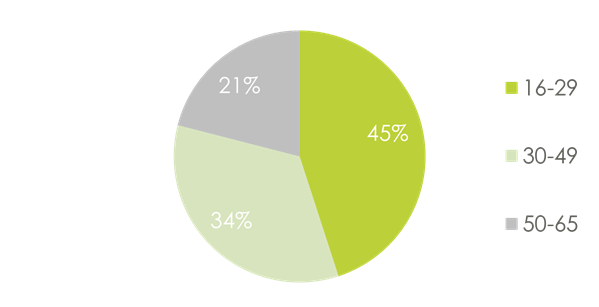Podcasting has rapidly gained popularity as a powerful medium for information, entertainment, and storytelling. With a growing audience and a unique ability to reach specific target groups, it provides advertisers with a valuable opportunity to connect with their audience on a deeper level and convey the desired message more effectively. But what communication strategy is best suited for podcasting, and how does the effectivity of this advertising form distinguish itself from other forms of advertising? This paper is based on various studies on advertising in podcasts conducted by MeMo² a Kantar company, in collaboration with Tonny Media. The insights shed light on the impact of podcasting and how it can be optimized within brand and campaign strategies. In short, it serves as a practical guide for all advertisers seeking innovative ways to effectively convey their message.
High receptivity for podcast advertising
The popularity of podcasting is reflected in the steadily increasing percentage of Dutch people who listen to podcasts; currently, 56% of the Dutch population indicates that they (occasionally) listen to podcasts1. This makes advertising in podcasts an interesting addition to the media mix. The strength of this medium is further reinforced by the fact that Dutch individuals are most receptive to advertisements in podcasts compared to other online channels. The Media Reactions 20232 survey by Kantar reveals that advertising in podcasts is considered the #1 AdEquity channel within online channels.
Also, people are more receptive to advertisements in podcasts than to commercials on TV. Ad Equity measures how receptive consumers are to advertising messages through various media channels. Particularly, the age group of 16-29 years is notably open to advertisements in and around podcasts.

Figure 1: Receptivity Age Groups
The receptivity is, among other things, attributed to the deliberate choice to listen to specific podcasts, making podcasts consumed in a more active manner compared to, for example, radio. The same Media Reactions study indicates that media aligning well with a specific area of interest achieve high scores in terms of advertising receptivity. The intentional content choice consequently leads to a high degree of appreciation in podcasts. This, in turn, contributes significantly to the effectiveness of communication2.
Strong credibility and likeability
Various Podcast Impact studies conducted by MeMo² a Kantar company, in collaboration with Tonny Media, also reveal that advertisements in podcasts are evaluated more positively than other forms of branded content. Host reads – advertisements delivered in the same style as the respective podcast and voiced by the podcast creators – are generally evaluated as more fitting for the brand and the podcast. They are also considered more likeable than other forms of branded content. What really sets these podcast advertisements apart from other forms of branded content, is their ability to convey the message in a more credible manner. It is indicated nearly twice as often that the content of podcast advertisements is perceived as credible compared to other forms of branded content.

Figure 2 Podcast Advertising Benchmark compared to Branded Content Benchmark (Index)
This aligns with the insights from the earlier mentioned Media Reactions 2023 study: podcast advertisements are considered the most reliable of all online channels. The credibility of advertisements proves to be a significant driver for the effectiveness of advertisements in podcasts.
Additionally, podcast advertisements stand out in terms of likeability. Generally, podcast advertisements are already perceived as more likeable than other forms of branded content, but host-read podcast advertisements in Tonny Media podcasts are on average considered even more likeable than advertisements in other podcasts1.

Figure 3: Tonny Media's performance compared to the branded content benchmark
The strength of the "entertainment value" of the creative concepts in Tonny Media campaigns, coupled with their strong alignment with both advertisers and the content of the podcasts, likely contributes to the above-average perception of podcast advertisements as likeable.
Effectivity of podcast advertisements
From various Podcast Impact studies conducted by MeMo² a Kantar company, in collaboration with Tonny Media, it is also evident that host reads in podcasts have an impact on both brand objectives and purchase indicators. These studies involved comparing Brand KPI scores for podcast listeners exposed to podcast advertisements versus those who were not exposed to the respective advertisement.The findings indicate that podcast advertisements are exceptionally effective in increasing both ad and brand awareness, as well as proposition awareness1.

Figure 4: Uplift effects of Tonny Media podcast advertising
On top, Host read podcast advertisements manage to make an impact on a brand's image. Listeners exposed to advertisements within podcasts associate brands more strongly with the intended image values than listeners who are not exposed. While it may not be inherent for the image to shift significantly with large paid media campaigns, podcast advertisements can achieve this, in some cases, after just a few episodes.
Furthermore, these podcast advertisements primarily affect the ultimate purchase decision. Although consideration experiences a slight uplift, podcasts are particularly capable of converting (existing) consideration into preference and driving in-store visits or purchases. The efficient use of advertising within podcasts is crucial for advertisers. According to the same Campaign Effectiveness studies, the effect occurs after 3-4 episodes and increases with more episodes1. Within this range, advertisers can convey their message repeatedly and consistently to loyal listeners, leading to increases in brand indicators while avoiding ad fatigue.
Podcasttactics
What communication strategy is most effective for a brand when advertising through podcasts?
Podcast advertisements are ideal for strengthening the funnel position - from awareness to consideration and preference - and have an impact on brand image. Since most communication strategies originate from the AIDA model, we can compare the objectives derived from this model.
Advertising in podcasts is an ideal addition to the media mix for an Attention objective since the greatest uplift within the funnel is achieved in awareness.
While podcast advertisements also yield effects on an Interest objective with uplift in consideration, the impact is not as strong as the uplift in awareness. The advice is to complement podcast advertisements with other means in a communication strategy with an Interest objective to provide a greater boost on consideration. For example, this could be achieved by incorporating social content on the podcast's Instagram/TikTok channel.
For objectives focused on Desire and Action, podcast advertisements align well with the media mix, providing a strong uplift in preference and purchase. Therefore, podcast advertisements are an ideal tool to persuade people who already consider a brand to give it preference or make a purchase.
How to efficiently leverage the power of advertising in podcasts?
An essential nuance in assessing the effectiveness of advertising in podcasts is reach. While this medium continues to grow, it is important to be aware of the difference in objectives compared to mass media communication. On the flip side, advertising in podcasts brings unique advantages. For reaching large audiences, radio, for example, may be more cost-effective. However, the reach among podcast listeners can be tailored to a more targeted audience, making advertising within this group highly impactful. Additionally, advertising in podcasts, more than other forms of branded content, enjoys high receptivity and reliability assigned by consumers. This aligns with high likeability and credibility of podcast advertisements.
The previously mentioned attributes also imply that achieving the desired effect among the target audience doesn't require a large number of episodes. All of these aspects indicate a valuable opportunity for advertisers to connect with their target audiences and strategically position their brand with effectiveness and efficiency.
1 The insights into podcast advertisements were developed in collaboration with Tonny Media (Suus Veenhof and Titus van Dijk) and MeMo² a Kantar company (Sjoerd Reus, Lara Middelkoop, Estefania Parra Salazar, and Coen Kempen). The results cover the effects of nine campaigns from various national and international brands across different industries, deployed on Tonny Media titles. A comparison was made with other branded content and podcast advertisements on different platforms. The research focuses on podcast placements,, in the Netherlands.
The results were obtained using the award-winning crossmedia THX. Platform by MeMo² a Kantar company. Within the THX. Platform, campaign contacts from 50.000 users are passively recorded. This platform allows for the visibility of KPI uplift for various campaigns by comparing KPI scores of podcast listeners exposed to podcast advertisements versus those not exposed to the respective ad. Additionally, the podcast advertisements' performance on key creative elements influencing effectiveness has been made visible. Questions about this whitepaper can be directed to MeMo², a Kantar company, at info@memo2.nl.
2 Kantar Media Reactions 2023.
